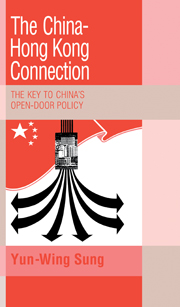Book contents
- Frontmatter
- Contents
- List of tables
- Preface
- Abbreviations
- Symbols
- Introduction
- 1 The open-door policy
- 2 The pivotal role of Hong Kong
- 3 The institutional setting
- 4 Evaluation of the open-door policy
- 5 Hong Kong as financier
- 6 Hong Kong as trading partner
- 7 Hong Kong as middleman
- 8 Summary and conclusions
- Appendix: Estimates of retained imports from China by commodity
- References
- Index
2 - The pivotal role of Hong Kong
Published online by Cambridge University Press: 01 June 2011
- Frontmatter
- Contents
- List of tables
- Preface
- Abbreviations
- Symbols
- Introduction
- 1 The open-door policy
- 2 The pivotal role of Hong Kong
- 3 The institutional setting
- 4 Evaluation of the open-door policy
- 5 Hong Kong as financier
- 6 Hong Kong as trading partner
- 7 Hong Kong as middleman
- 8 Summary and conclusions
- Appendix: Estimates of retained imports from China by commodity
- References
- Index
Summary
In examining the role of Hong Kong in China's trade, it is important at the outset to distinguish between trans-shipment, entrepôt trade, and direct trade.
Trans-shipment means that goods are consigned directly from the exporting country to a buyer in the importing country, although the goods are transported via an entrepôt and may be temporarily stored at the entrepôt for onward shipment. Trans-shipped goods may change their mode of transportation at the entrepôt: Chinese goods, for example, are carried by train or coastal vessels to Hong Kong where they are consolidated into containers. Trans-shipped goods are not usually regarded as part of the trade of the entrepôt and they do not clear customs because they represent goods in transit and are not imported into the entrepôt.
Unlike trans-shipment, entrepôt trade is indirect trade, as imports for re-export are consigned to a buyer in the entrepôt and the buyer takes legal possession of the goods after clearing customs. These imports may then be processed before being re-exported; processing may include packaging, sorting, grading, bottling, drying, assembling, decorating, diluting, or even minor manufacturing (such as the pre-shrinking of grey cloth). According to the official definition in Hong Kong, any manufacturing process that permanently changes the shape, nature, form, or utility of the basic materials used in manufacture would turn the product into a domestic export, that is, an export manufactured in Hong Kong.
- Type
- Chapter
- Information
- The China-Hong Kong ConnectionThe Key to China's Open Door Policy, pp. 15 - 43Publisher: Cambridge University PressPrint publication year: 1991

